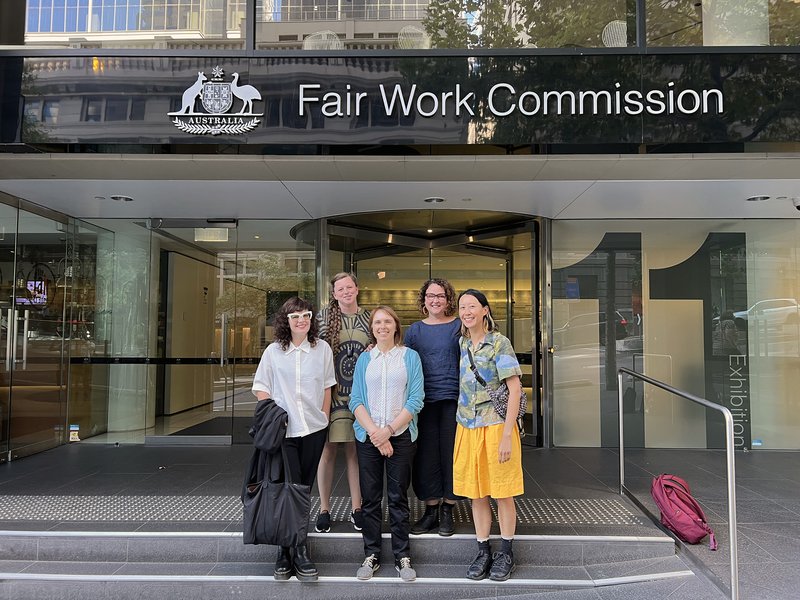Visual arts sector advocates for award coverage
Visual artists and arts workers raised concerns of inadequate award coverage and low wages with the Fair Work Commission as part of the Modern Awards Review.
Visual artists and arts workers raised concerns of inadequate award coverage and low wages with the Fair Work Commission as part of the Modern Awards Review.

The Fair Work Commission’s two-week consultation period on arts and culture for the Modern Awards Review 2023-2024 concluded last week. The review, aligned with the Government’s National Cultural Policy Revive, aims to investigate coverage gaps and minimum standards in the sector.
NAVA facilitated the participation of nearly 20 visual artists and arts workers in in-person discussions, who highlighted the lack of adequate coverage and its impact on unpaid or underpaid work. Written submissions were also made late last year.
Independent artists and arts workers Andy Butler, Channon Goodwin, Eugenia Lim, Jordan Marani, Angela Powell, Lisa Radford, Beatrice Rubio-Gabriel, Madeleine Thornton-Smith, Ana Tiquia and Simone Tops shared insights into their diverse work engagements, emphasising their extensive specialisation, often working long hours for less than minimum wage. Despite achieving national or global acclaim, many practitioners struggle to make ends meet with income levels below the poverty line.
The artists and arts workers clarified that operating as sole traders is currently the only way to get paid. In the visual arts, there is a heavy reliance on contractors often due to short-term funding and or for administrative simplicity, favouring invoicing over payroll complexities. Given the choice between having their own Australian Business Number (ABN) and public liability insurance or opting for part-time employment contracts, most artists and arts workers expressed a preference for the latter. They highlighted the importance of inclusive contracts offering sick pay, holiday and long-service leave, financial stability, job security, and superannuation.
Drawing parallels with the performing arts, they cited the benefits of union support in gaining increased government support when better conditions and wage increases are negotiated through their award process. Additionally, it was discussed how employment contracts can safeguard Intellectual Property (IP) and Indigenous Cultural Intellectual Property (ICIP).
From the Australian Centre for Contemporary Art (ACCA), artists and Front of House (FOH) staff, including Emily Hubbard, Beatrice Rubio-Gabriel, and Executive Director Claire Richardson, recounted their three-year negotiations for an Enterprise Bargaining Agreement (EBA). Their aim was to provide more fitting coverage for employees, restructuring pay grades to better match the nature of their work in absence of suitable coverage within the Amusement, Recreation and Entertainment Award 2020.
Tracy Burgess of Gertrude Contemporary, Dr Rebecca Coates of the Monash University Museum of Art (MUMA), Anne Robertson of the Public Galleries Association of Victoria (PGAV) and National Public Galleries Alliance (NPGA), and Claire Watson of NETS Victoria highlighted the sector’s reliance on adapted instruments due to the absence of a dedicated award. They stressed the need for clarity and consistency, calling for a nuanced grading system reflecting job complexity, programming hours and gallery grading levels to ensure adequate remuneration.
Professor Grace McQuilten, Associate Professor Marnie Badham and Research Assistant Chloë Powell from RMIT University’s School of Art Visual Arts Work research team presented their findings on the hybrid nature of being both an artist and an arts worker as well as economic data on visual arts careers. They emphasised the significance of using the term ‘art’ in award titles and industry descriptors.
NAVA highlighted the timing of this consultation, which coincided with the holiday season and Invasion/Survival Day resulted in limited engagement from First Nations artists and sector colleagues. It is imperative to recognise the unique challenges faced by First Nations practitioners, including precarious work, low incomes, and workplace racism. Reports indicate that First Nations artists earn significantly less than the sector average and arts workers often experience a high cultural load in their workplaces. Establishing a dedicated award could help provide clearer access to workplace protections under the Fair Work Act.
NAVA emphasised the preference for a standalone award providing comprehensive cover and adequate protections for all workers in the visual arts. However, resistance exists to creating industry-specific awards to minimise the proliferation of new awards. Consequently, the Fair Work Commission may lean towards expanding an existing award to better accommodate the visual arts sector.
Modern awards aim for broad applicability across various employers and occupations. NAVA pointed out the deficiencies in the Amusement, Events, and Recreation Award, which falls short of addressing the hybridity of roles and responsibilities, specialised knowledge and skills, and the hierarchy of roles unique to the visual arts, resulting in confusion over payment rates and working conditions.
Establishing a Visual Arts Award presents a significant opportunity to rectify these issues, ensuring proper remuneration, fostering career development, and tackling industry retention challenges. At the very least NAVA’s efforts likely spurred the Fair Work Commission to recognise the need for change.
The Modern Awards Review 2023-2024 final report is expected to be published on or about 28 June 2024.
L-R: NAVA Executive Director Penelope Benton, Research Assistant Chloë Powell, Professor Grace McQuilten, and Associate Professor Marnie Badham from RMIT University’s School of Art Visual Arts Work research team, and artist Eugenia Lim in front of the Fair Work Commission building in Naarm.
ID: A group of five people standing in front of a building and under a sign that says 'Fair Work Commission'